Must-Try Spanish Food for Food Lovers
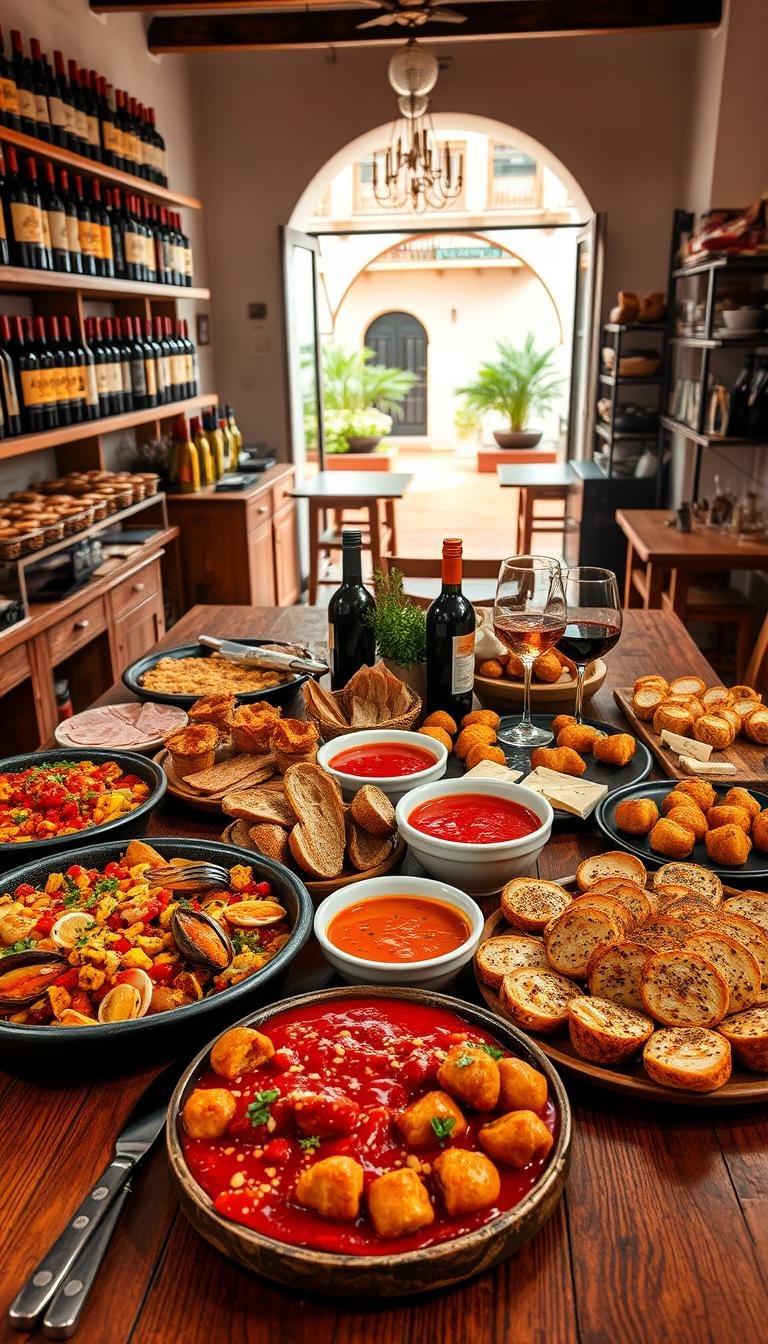
Have you ever enjoyed a meal with loved ones that fills you with comfort and excitement? That’s the essence of Spanish cuisine. Picture tasting a variety of flavors. From the strong taste of paella to the filling tortillas. It’s not just food; it’s a trip through history and culture in each bite.
Are you an experienced cook or just starting out? Spanish cuisine will make you happy. Every bite tells its own story. Each dish shows the richness of Spain, the people’s passion, and the tradition of family meals. Are you ready for this tasty journey? Let’s look at some amazing Spanish foods you must try!
Key Takeaways
- Paella: A traditional dish from Valencia, made with rice, saffron, olive oil, and various proteins and vegetables
- Tapas: Small, flavorful dishes like Patatas Bravas, Gambas al Ajillo, and Jamón Ibérico, often enjoyed in social settings
- Gazpacho: A cold tomato-based soup from Andalusia, made with cucumbers, bell peppers, onions, garlic, and olive oil
- Tortilla Española: A Spanish omelette made with eggs, potatoes, onions, and olive oil
- Empanadas: Crescent-shaped pastries filled with seasoned ground beef, olives, almonds, and raisins
The Rich History and Culture of Spanish Cuisine
Spanish cuisine is loved for its bold tastes and deep history. It mixes many cultures like the Phoenicians, Greeks, and Romans. Also, the Moors and Jews added their touch. Together, they created the dishes we enjoy today.
Influences from Various Regions
Ever wonder why Spanish food has so many flavors? Spain was a place where many cultures met. The Moors brought rice, saffron, and sweet dishes. Then, the Americas added tomatoes, chocolate, and more. Being by the sea means Spain has lots of fresh seafood in its meals.
Traditional Cooking Techniques
Traditional cooking is key in Spain. They slow-roast and wood-fire food, making it tasty. Imagine lamb roasted with herbs. It’s delicious.
These methods show the true spirit of Spanish food. Using fresh, local stuff, Spain creates unique dishes. Its nature gives amazing ingredients for these recipes.
Spanish meals are a journey through time. They show the impact of many regions and cooking styles. Every dish tells a story of Spain’s unique eating culture.
Essential Ingredients in Spanish Cooking
Spanish cooking is known for a few key ingredients. These ingredients make the food unique and tasty. Let me share what I’ve learned from my trips through Spain!
Olive Oil: The Heart of Spanish Dishes
Olive oil is very important in Spanish food. Spain is a top producer of olive oil. This oil is a must-have in dishes like “ensalada” and “paella.” It’s used in many ways, like sautéing veggies and on bread. Can you picture a Spanish kitchen without it?
About 44% of the world’s olive oil comes from Spain!
Herbs and Spices That Elevate Flavors
To really get the Spanish taste, you can’t skip the spices and herbs. Saffron is a must for the famous “paella.” It gives the dish its golden color and unique taste. Paprika adds a special flavor to meats like chorizo. Don’t forget about parsley and bay leaves. They make stews and soups smell amazing. These spices change a meal from okay to wonderful!

The Importance of Fresh Produce
Fresh veggies and fruits are key in Spanish meals. Ingredients like tomatoes, onions, and garlic create the famous “sofrito.” Citrus fruits make salads and desserts pop. Potatoes are a must for “tortilla española.” Bread is a staple in Spain, eaten with most meals. And jamón is a famous cured ham found in markets. It’s very tasty.
| Ingredient | Use |
|---|---|
| Saffron | Paella, stews |
| Paprika | Chorizo, sausages |
| Olive Oil | Salads, meats, bread |
| Tomatoes | Salads, gazpacho |
| Onions | Sofrito, sauces |
| Garlic | Aioli, romesco sauce |
Spanish cooking really cares about fresh, quality ingredients. Using these staples and seasonal veggies, you can make true Spanish dishes. They’re healthy and yummy. Why not try it out?
Tapas: The Art of Spanish Snacking
In Spain, enjoying tapas is a key part of the culture. These little dishes mix many flavors and textures. Perfect for sharing, they range from olives to yummy Gambas al Ajillo. Every tapa gives a special taste of Spain.
Tapas are more than just food; they’re a way to connect with others. Imagine going from bar to bar, trying different Spanish flavors. It’s an adventure in food that unites people, turning meals into celebrations. Want to know what tapas are and how to pair them with drinks? Let’s jump right in!
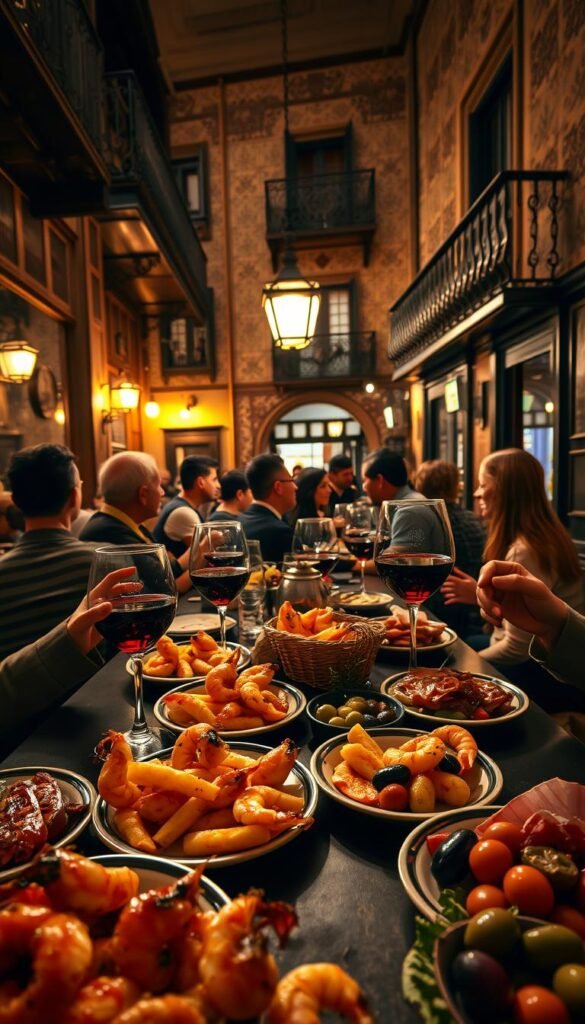
Popular Traditional Tapas
Tapas go from simple to fancy. You’ve got to try dishes like *patatas bravas*, jamón serrano, and *croquettes*. Don’t leave out *manchego cheese* and calamari! For seafood lovers, dishes like Gambas al Ajillo and *pulpo a la gallega* are must-haves.
| Type | Description |
|---|---|
| Cosas de picar | Nibble foods like olives and nuts |
| Pincho | Foods served on skewers or toothpicks |
| Cazuela | Sauces and dishes served in small plates |
For the very hungry, *raciones* offer more food. Pinchos are small tapas on bread. They’re another great way to enjoy these quick Spanish snacks.
Pairing Tapas with Drinks
Drinks are a big part of the tapas experience. Tapas go well with beer, wine, or *sangria*. Many bars in Spain pick wines that match perfectly with certain tapas. This makes every bite even better.
Thinking about a tapas party at your place? It’s easy! Just pick some tapas, grab good wine, and get ready for fun. You can bring the joy of Spanish bars to your living room. Isn’t that a cool way to party?
So, if you want to try Spanish flavors explained in small, yummy bites, let tapas lead the way. Every dish has its own story. Together, they weave a wonderful experience of tastes that’ll have you cheering, “¡Olé!”
Iconic Spanish Dishes You Can’t Miss
If you love food as much as I do, you must try these iconic Spanish dishes! They’re not just tasty. They show what authentic Spanish cuisine is about and bring Spanish flavors around the world to you.
Paella: A Culinary Masterpiece
Paella is a gem from Valencia. It’s truly a culinary work of art. With chicken, rabbit, saffron, and beans, it captures the heart of paella.
The magic is in the socarrat – the crispy, caramelized rice at the bottom. Every bite is a piece of Spanish tradition and history!
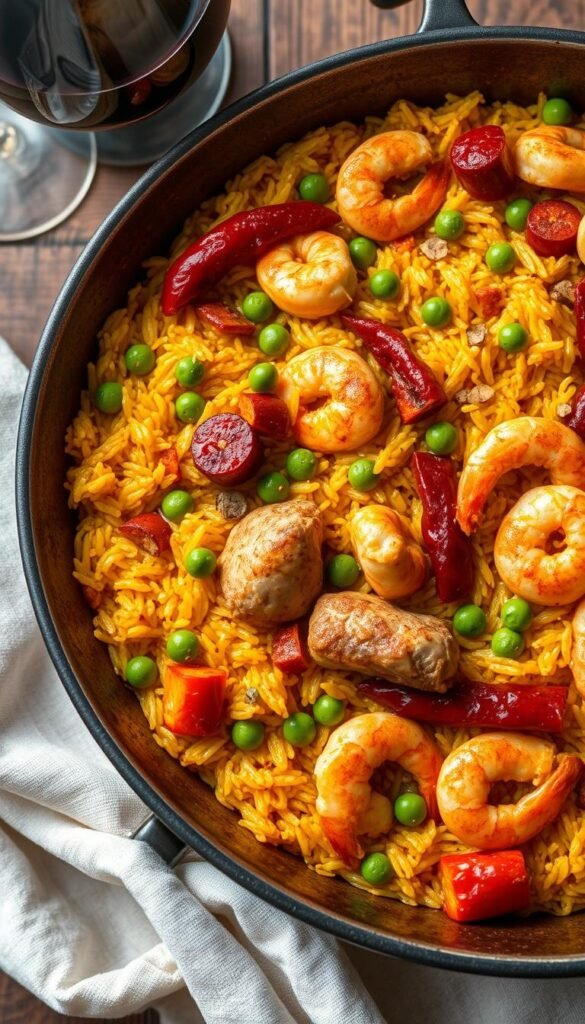
Gazpacho: Refreshing Summer Soup
In the summer heat, nothing is better than cold gazpacho. It comes from Andalucía. This soup has ripe tomatoes, olive oil, garlic, bread, peppers, and cucumber.
It shows how simple ingredients can turn into something amazing. Imagine drinking this on a hot day!
Jamón Ibérico: A Taste of Spain
To really know Spanish food, you must try Jamón Ibérico. This special ham comes from black pigs that roam free. It’s smooth, velvety, and has a nutty taste.
Thinly sliced and maybe with olive oil, it offers a true flavor of Spain’s countryside.
| Dish | Main Ingredients | Origin |
|---|---|---|
| Paella Valenciana | Rice, chicken, rabbit, saffron, beans | Valencia |
| Gazpacho | Tomatoes, olive oil, garlic, bread, peppers, cucumber | Andalucía |
| Jamón Ibérico | Iberian black pig ham | Spain |
Regional Specialties of Spain
Spain offers a variety of local dishes. Each dish shows off the special ingredients and customs of Spain. From Catalonia’s sunny coasts to Andalusia’s old lands, the country’s food scene is rich and varied.
Catalonia’s Culinary Treasures
Catalonia is famous for its wide range of Spanish dishes. Picture enjoying Calcots, grilled spring onions with a tasty romesco sauce. It’s a beloved spring treat! And the Xuixo from Girona, a sweet pastry filled with cream, is a must-try.
Another highlight is Paella Valenciana. Though it comes from Valencia, this dish fits Catalonia’s coastal taste. It mixes seafood, rice, and veggies perfectly.
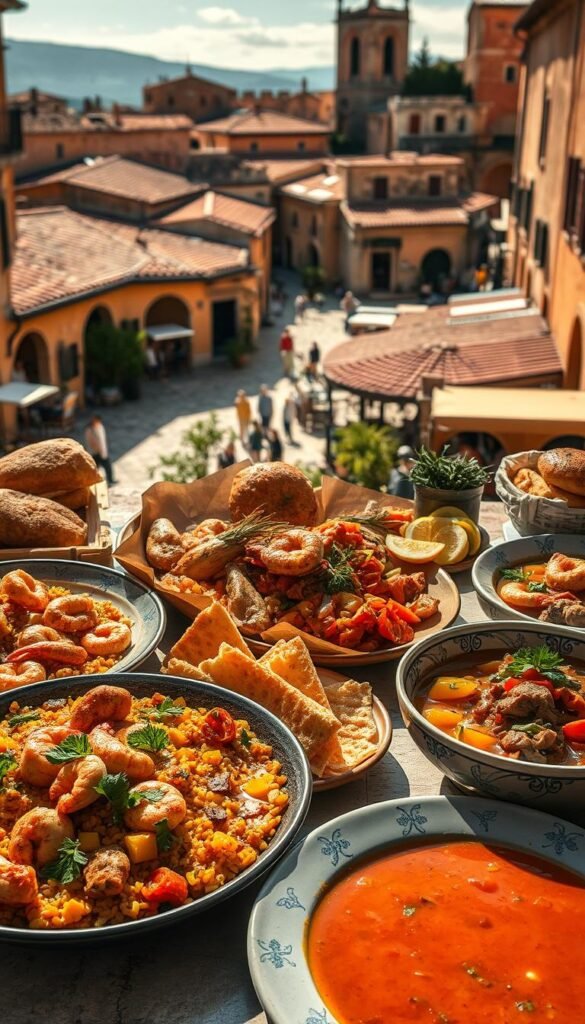
Andalusian Flavors and Traditions
Andalusia is known for classic Spanish cuisine. Its famous Gazpacho is a cold vegetable soup. Perfect for hot summer days, it showcases Andalusia’s fresh veggies and bold flavors.
Cochinillo Asado, or roasted suckling pig, is another star. Hailing from Segovia, it’s known for its crispy skin and tender meat. This dish is all about tradition and celebration.
Spain’s food varies from place to place. From Fabada Asturiana‘s hearty appeal to Madrid’s tasty Bocadillo de Calamares. Every dish paints a picture of Spain’s rich food culture. It’s like a journey through the country’s colorful landscapes and deep history with every bite.
Street Food in Spain: A Culinary Adventure
Embarking on a journey of Spanish street food is exciting. It lets you experience Spain’s dynamic culture and tastes. Each bite into crispy churros dipped in rich chocolate, or a savory bocadillo, showcases Spanish cooking skills. Ready to explore these delightful Spanish street foods?

Churros and Chocolate: A Sweet Delight
Picture biting into fresh, crispy, golden churros covered in sugar. Now, add a cup of thick, creamy chocolate for a timeless Spanish treat. This combo is loved by everyone, showcasing Spain’s classic flavors. Whether from a street stand or a cafe, churros and chocolate make a perfect sweet treat.
Bocadillos: The Spanish Sandwich
Bocadillos are essential to Spanish dining, offered at dinners and lunches. Made with crusty bread and filled with tasty things like chorizo or calamari, they’re flavorful and satisfying. In Madrid, don’t miss the Bocadillo de Calamares, with crispy calamari and lemon in a baguette. It’s like holding the essence of Spain’s streets in your hands.
| Dish | Region | Description |
|---|---|---|
| Churros con Chocolate | Madrid | Deep-fried dough pastries enjoyed with thick chocolate |
| Bocadillo de Calamares | Madrid | Crispy calamari rings in a baguette with lemon |
| Patatas Bravas | Barcelona | Fried potatoes with spicy tomato sauce and aioli |
| Pulpo a la Gallega | Galicia | Octopus with paprika and olive oil, served on a wooden plate |
| Pinchos | Basque Country | Bite-sized treats with various ingredients on a stick |
Spanish Desserts That Will Tempt Your Taste Buds
Some *Spanish desserts* are real standouts, like Flan and Tarta de Santiago. They make any meal end sweetly. These treats capture *Spanish flavors* well. They’re also *easy family-friendly Spain food*.
Flan: A Creamy Classic
Flan is a dessert you must try. It’s creamy, has caramel on top, and tastes like vanilla. It’s made with eggs, milk, and caramelized sugar. Everyone in Spain loves it. The mix of smooth custard and caramel sauce is a favorite among all ages.
Tarta de Santiago: Almond Cake Heaven
The Tarta de Santiago comes from Galicia. It’s rich in history. This almond cake is moist and often features the cross of Saint James in sugar. It’s beautiful and tastes amazing. It really shows off the real *Spanish flavors*.
Trying *Spanish desserts* like Flan and Tarta de Santiago is a wonderful experience. They close a meal with elegance and simplicity. These desserts are great for any cook level. They will impress anyone and make your sweet tooth happy.
Exploring Spanish Wine and Cider
Spanish wine and cider add a special touch to meals in Spain. Enjoying a bold Rioja or a fresh Sidra can make your food taste better. These drinks show the hard work that goes into making them!
Let’s dive into the world of Spanish wines and ciders!
The Diversity of Spanish Wines
Spanish wines come in many types, thanks to the country’s various landscapes and weather. You can find everything from rich reds in Rioja to fragrant whites in Rías Baixas. They go great with slow-cooked dishes like Paella or Fabada Asturiana.
Foods like Jamón Ibérico, Pisto Manchego, and Patatas a la Riojana taste better with wine. Imagine visiting bars and trying these foods and wines. What a fun experience!

Introduction to Sidra: Spanish Cider
In places like Asturias, Sidra, or cider, is very popular. In fact, most of Spain’s cider comes from there. They make Sidra Natural without adding anything else, keeping its taste pure. Pouring Sidra from up high is an art that adds air to it, done by professionals called escanciador.
People in Asturias drink more than 50 liters of cider each year! Going to a chigre (cider bar) and seeing how they pour cider is a real treat. Cider with slow-cooked Spanish dishes is a tasty mix.
Enjoying Spanish wine or Sidra lets you taste Spain’s amazing food culture. Why not try a glass with your next meal? It’s a real treat!
Discovering Spanish Olive Oils
Let’s explore Spanish Olive Oils, essential in Spanish cooking! Spain makes 45% of the world’s olive oil. That’s the most anywhere. It’s famous for its strong tastes and deep cooking history.
In Spain, over 200 kinds of olives are grown. About 30 types are for cooking oils. Each one has its own special flavor, like Picual, Manzanilla, and Cornicabra. They add unique touches to dishes.
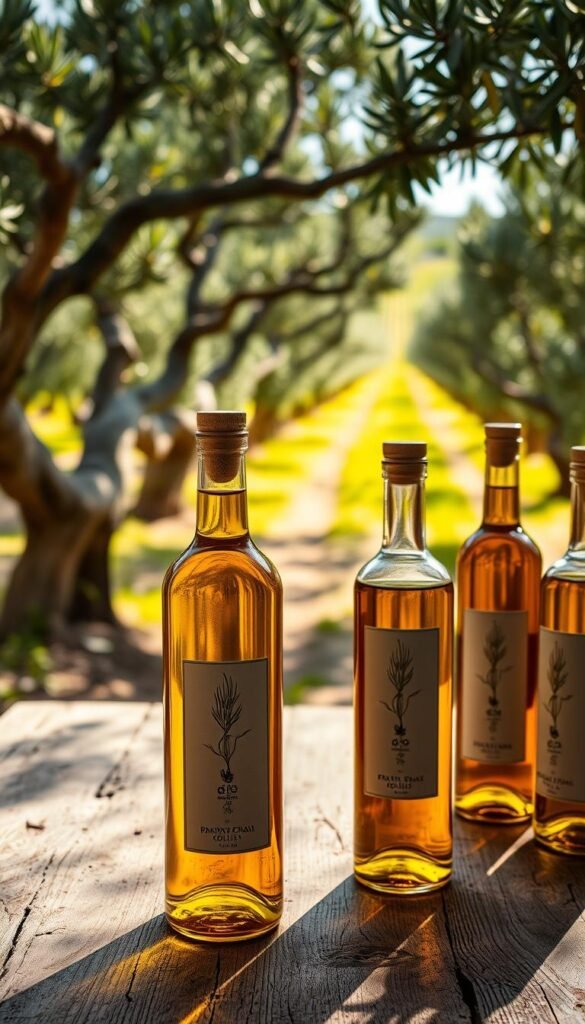
Types of Olive Oils and Their Uses
Knowing about Spanish Olive Oils helps chefs a lot! Picual is good for hearty meals like paella. Manzanilla is great in soft dishes, thanks to its mild taste. Cornicabra adds spice to Mediterranean recipes.
Extra virgin and virgin olive oils are top picks. They’re cold-pressed and natural. These oils taste great and are good for your health. They help manage cholesterol and fight inflammation.
How to Choose the Best Spanish Olive Oil
Picking the right Spanish Olive Oil can make cooking special. Look for “DO” on labels. It shows the oil is from a top region. Baena, Bajo Aragón, and La Rioja have the finest oils.
Try artisanal oils for something special. Many Spanish oils are made with care, giving them unique tastes. Foods like Gambas al Ajillo and Tortilla Española taste amazing with these oils.
Spanish Olive Oils are a key part of their culture. They make Spanish dishes even better. Start exploring these flavors today!
Celebrating Festivals with Spanish Food
Spanish culinary festivals are a feast for the senses. Experiencing these events is the best way to dive into Spanish culture. From the big Feast of San Isidro to the fun La Tomatina, these food festivals celebrate Spanish dishes, heritage, and community.
Feast of San Isidro: A Culinary Journey
The Feast of San Isidro happens every year in Madrid. It shows off traditional Spanish dishes. You’ll enjoy paella, tapas, churros, and jamón ibérico. It’s a food lover’s dream.
The event is organized by students from Flagler College. They get real-world experience in hospitality and event planning.

| Key Features | Details |
|---|---|
| Importance | An annual event celebrated in Madrid, emphasizing traditional recipes from Spain. |
| Activities | Sampling traditional Spanish dishes, engaging in cultural traditions, and fusion cooking. |
| Impact | Proceeds support academic scholarships and professional development for Flagler College’s hospitality students. |
La Tomatina: A Food Fight with Tradition
La Tomatina happens in Buñol, near Valencia. It’s unique because it mixes food and tradition in a fun way. This event is known for its huge tomato fight.
Whether you join the tomato battle or try different snacks, you’ll have fun. La Tomatina promises delicious food and great memories for all.
How to Create a Spanish-Inspired Meal at Home
Making a Spanish meal at home is fun. You can use ingredients like saffron and pimentón. These help you cook dishes that feel real yet match your tastes. Whether it’s for a party or dinner at home, you’ll learn to cook Spanish food well.
Key Ingredients for Authentic Recipes
You’ll need top-notch olive oil, saffron, and pimentón (Spanish paprika). Olive oil adds deep flavor to many dishes. Saffron gives paella its color and smell. Pimentón has different tastes, from sweet to smoky. It’s used in dishes like patatas bravas and chorizo.

Also, get fresh veggies! Tomatoes, peppers, onions, and garlic are key. They blend to make tasty dishes. Like pan con tomate and gazpacho.
Tips for Cooking Spanish Dishes
Cooking Spanish food right means mastering certain skills. For example, making a tortilla de patatas takes time. The potatoes and onions have to be cooked gently. And for paella, getting a crispy bottom, or “socarrat”, is crucial.
Right cookware is also important. A “paellera,” or paella pan, helps cook evenly and get that socarrat. For tapas, little clay dishes are best.
Try out these methods and ingredients for great meals. Imagine serving tortilla de patatas, gambas al ajillo, and sangria. Your home will feel like Spain!
Start cooking Spanish dishes with excitement and some tips. Enjoy your cooking!
Resources for Spanish Food Lovers in the U.S.
If you love Spanish food, there’s good news for you! The U.S. has many ways to enjoy Spanish tastes without flying away. You can try authentic Spanish meals at restaurants. Or you can cook Spanish dishes at home using cookbooks and online recipes. This way, you can enjoy Spanish flavors right where you live.
Spanish Restaurants to Visit
Want to taste the best Spanish food? There are many Spanish places in the U.S. where you can eat delicious meals. Try tapas at Jaleo by Chef José Andrés, like patatas bravas and tortilla de patatas. Or eat a tasty paella at Bulla Gastrobar. These places give you a real taste of Spain. They bring Spain’s food and culture right to you.
Cookbooks and Online Recipes to Explore
Like cooking? There are lots of cookbooks and websites to help you make Spanish food. Get “The New Spanish Table” by Anya von Bremzen to start. Or check out Spanish Sabores online for recipes on Gazpacho to Churros. These resources are great for any cook. They help you bring Spanish tastes into your kitchen.